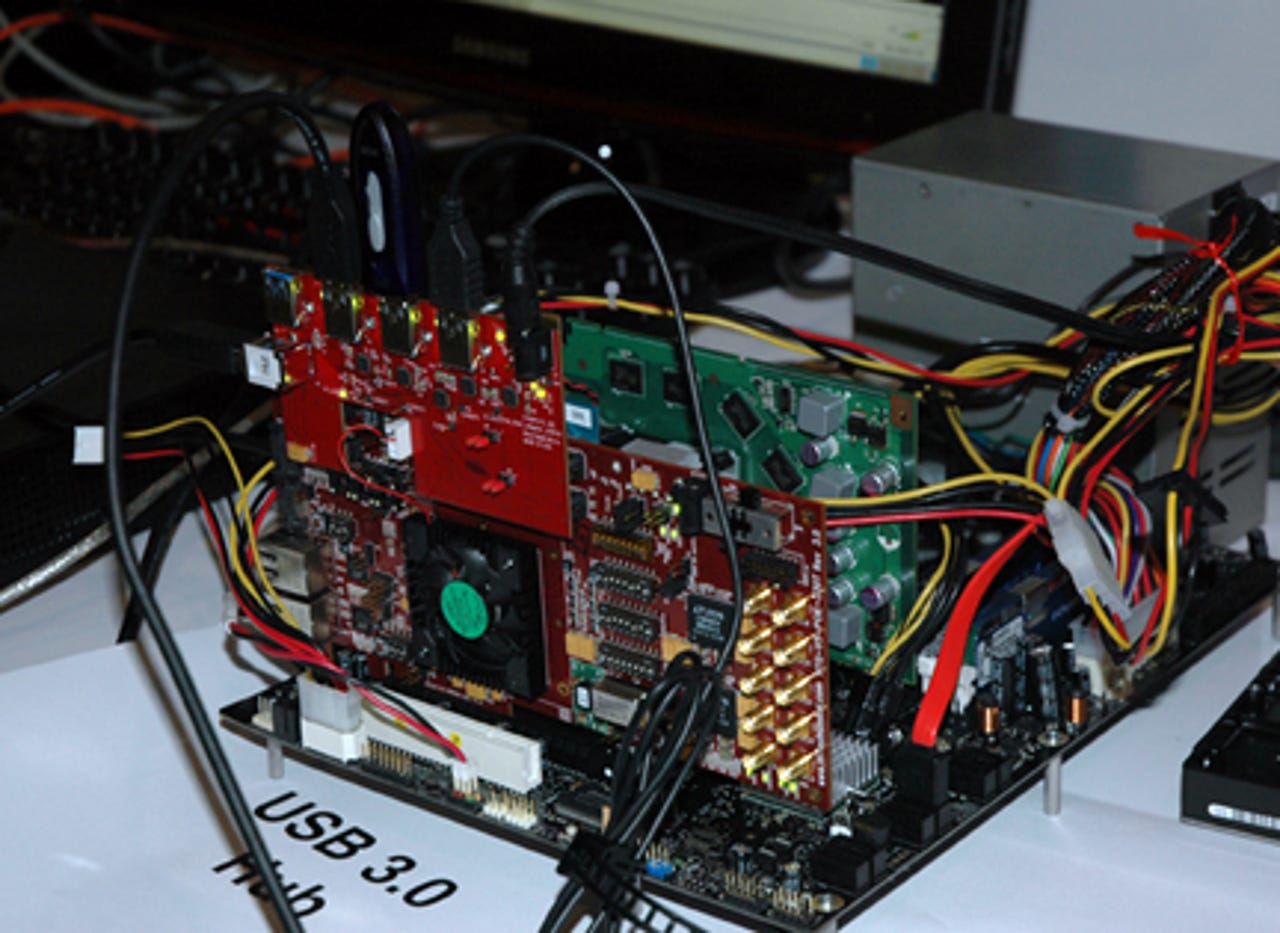Gallery: Hottest tech from IDF 2009
Check out the technology that attracted ZDNet UK editor Rupert Goodwins at IDF in San Francisco where he captured the hightlights.

1 of 11 Andy Smith/ZDNET
ZDNet UK editor Rupert Goodwins walked the floor at the Intel Developer Forum in San Francisco where he captured the hightlights.
The Intel Developer Forum always has a theme. This year, it's scribbles. Whiteboards throughout the event invite passing engineers and others to write down their ideas, predictions, wishes and observations — as demonstrated by a giant engineer covering the conference center with graffiti.
Captions and Photo Credit: Rupert Goodwins
2 of 11 Andy Smith/ZDNET
Intel is always keen to lead by example, often with concept devices that show where the company wants the market to go. Here, the 2009 concept laptop sprouts three touch sub-screens under the main display, each capable of showing content, widgets or user interface components. Why three instead of one long one? Nobody makes long ones.
Credit: Rupert Goodwins
3 of 11 Andy Smith/ZDNET
This Umid Atom-powered ultra-mini-notebook/mobile internet device/micro-netbook (choose one) is the closest we've seen to our favourite portable form factor, the Psion Series 5. Now, if only they could get the battery life and responsiveness up to Psion's standards as well, they could be onto something.
Credit: Rupert Goodwins
4 of 11 Andy Smith/ZDNET
One of the most exciting demonstrations of the show used seven of these experimental SSDs to produce 4Gbps hard disk throughput and a million disk operations a second. That's just by taking standard SSD chips and giving them a PCIe interface, which promises great things for the very near future once this mix of technologies is commercialized.
Credit: Rupert Goodwins
5 of 11 Andy Smith/ZDNET
Intel unveiled a new micro-server format, which it says will let people build high-power systems in small spaces without having to get into blades, racks and all those old ideas. It can only support a single processor — but with eight cores coming down the road, that's not the limitation it used to be.
Credit: Rupert Goodwins

6 of 11 Andy Smith/ZDNET
Your next USB hub won't look like this - unless you really need USB 3.0 right now this minute. It might look messy, but this is the final stage of development before consumer-grade products arrive: the standard is progressing fast.
Credit: Rupert Goodwins
7 of 11 Andy Smith/ZDNET
Any new standard needs test equipment, and this is currently the only way to give USB 3.0 a good thrashing before deciding it's good enough to sell. Each individual USB signal is rapidly tweaked and the results carefully analyzed, at the sort of speeds that only five years ago would have needed a box the size of the Tardis to manage.
Credit: Rupert Goodwins
8 of 11 Andy Smith/ZDNET
These two cards contain complete TV, digital radio and GPS receivers. Or rather, they don't — they contain just enough silicon to convert any radio signal on the VHF and UHF bands to a bitstream, and the host PC then does all the work to extract the information. Software-defined radio is here to stay.
Credit: Rupert Goodwins
9 of 11 Andy Smith/ZDNET
Crosstown traffic won't be the same if this Intel invention takes off: your brake lights and junction traffic signals will be modulated with 200Kbps data that constantly relays information to your vehicle and others about what's happening ahead and behind. It’s like radio networking, but much cheaper and with no need for a license.
Credit: Rupert Goodwins
10 of 11 Andy Smith/ZDNET
Ever wondered what 100Gbps from a desktop system would look like? This. By bonding together multiple 10Gbps signals and very smart network controllers, incredible throughput is achieved without slugging the host system to death.
Credit: Rupert Goodwins
11 of 11 Andy Smith/ZDNET
Intel's Turbo Mode monitors the state of a processor chip and overclocks components as much as it can while staying within the thermal limits. Here, the next generation Turbo Mode checks the temperature of two components — the graphics and the processor die — so that when they're in the same package, they can each use as much or as little of the thermal headroom as they need.
Credit: Rupert Goodwins
Related Galleries
Holiday wallpaper for your phone: Christmas, Hanukkah, New Year's, and winter scenes
![Holiday lights in Central Park background]()
Related Galleries
Holiday wallpaper for your phone: Christmas, Hanukkah, New Year's, and winter scenes
21 Photos
Winter backgrounds for your next virtual meeting
![Wooden lodge in pine forest with heavy snow reflection on Lake O'hara at Yoho national park]()
Related Galleries
Winter backgrounds for your next virtual meeting
21 Photos
Holiday backgrounds for Zoom: Christmas cheer, New Year's Eve, Hanukkah and winter scenes
![3D Rendering Christmas interior]()
Related Galleries
Holiday backgrounds for Zoom: Christmas cheer, New Year's Eve, Hanukkah and winter scenes
21 Photos
Hyundai Ioniq 5 and Kia EV6: Electric vehicle extravaganza
![img-8825]()
Related Galleries
Hyundai Ioniq 5 and Kia EV6: Electric vehicle extravaganza
26 Photos
A weekend with Google's Chrome OS Flex
![img-9792-2]()
Related Galleries
A weekend with Google's Chrome OS Flex
22 Photos
Cybersecurity flaws, customer experiences, smartphone losses, and more: ZDNet's research roundup
![shutterstock-1024665187.jpg]()
Related Galleries
Cybersecurity flaws, customer experiences, smartphone losses, and more: ZDNet's research roundup
8 Photos
Inside a fake $20 '16TB external M.2 SSD'
![Full of promises!]()